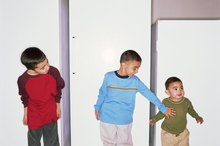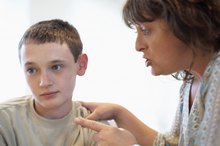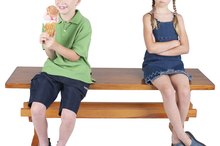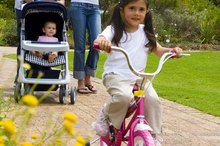Strategies to Help Children with Aggressive Behavior
Frustration and anger often manifest themselves as hitting, pushing, biting and other aggressive behaviors in young children 1. Teaching children how to handle their feelings reduces the aggressive behaviors by giving them alternative outlets 1. Children respond to situations differently, so offering them several strategies allows them to find the method that works best.
Get Physical
Physical activities engage a child in a specific task to help distract him from aggressive behaviors. The physical activity allows the child to channel his frustration or anger into the action. Outdoor physical activities give a child plenty of room to burn off energy and frustration. Ideas include running a specific path, shooting hoops or kicking goals into a soccer net. Indoor physical activities also work. You can let the child pound on modeling clay, do jumping jacks or bounce a ball.
- Physical activities engage a child in a specific task to help distract him from aggressive behaviors.
- The physical activity allows the child to channel his frustration or anger into the action.
Talk It Out
The Benefits of Cooking With Children
Learn More
Children often struggle to express their feelings of anger or frustration, which can lead to aggressive behaviors 1. Helping a child discuss her feelings offers an alternative outlet. Acknowledge the feelings of anger and let your child know that everyone feels angry occasionally. Teach your child to say, "I'm angry," when a situation arises. Help her talk through the cause of her anger once she calms down enough to discuss it. Other techniques, such as counting to 10 in a frustrating situation or breathing deeply, offer additional calming benefits that can help defuse the situation.
- Children often struggle to express their feelings of anger or frustration, which can lead to aggressive behaviors 1.
- Acknowledge the feelings of anger and let your child know that everyone feels angry occasionally.
Cool-Down Spot
Timeouts provide an opportunity for a child exhibiting aggressive behaviors to calm down. To create a more positive feeling toward a timeout, call it a cool-down spot. The spot gives the child a place to go when he begins heading toward aggressive behaviors. When you notice that he is getting upset, suggest that he take some time in his cool-down spot. To make the cool-down spot less of a punishment and more of a calming tool, place a few items in the cool-down spot that help your child calm down. These might include a stress ball, a favorite stuffed animal, a book or paper and a pencil. With consistent use, your child might send himself to the cool-down spot when he begins feeling frustrated.
- Timeouts provide an opportunity for a child exhibiting aggressive behaviors to calm down.
- To make the cool-down spot less of a punishment and more of a calming tool, place a few items in the cool-down spot that help your child calm down.
Act It Out
How to Teach Kids to Respect Other's Personal Space
Learn More
Role playing gives your child a chance to practice dealing with frustration when she is calm. Choose a time when your child is content rather than when she is exhibiting aggressive behaviors. Think of a situation that would normally make her upset. Using actual situations that have happened recently works well for the role playing. Act out the situation with her so she can practice handling it in a more productive way. Give her some suggestions for ways to handle upsetting situations.
- Role playing gives your child a chance to practice dealing with frustration when she is calm.
Related Articles
References
Writer Bio
Based in the Midwest, Shelley Frost has been writing parenting and education articles since 2007. Her experience comes from teaching, tutoring and managing educational after school programs. Frost worked in insurance and software testing before becoming a writer. She holds a Bachelor of Arts in elementary education with a reading endorsement.









